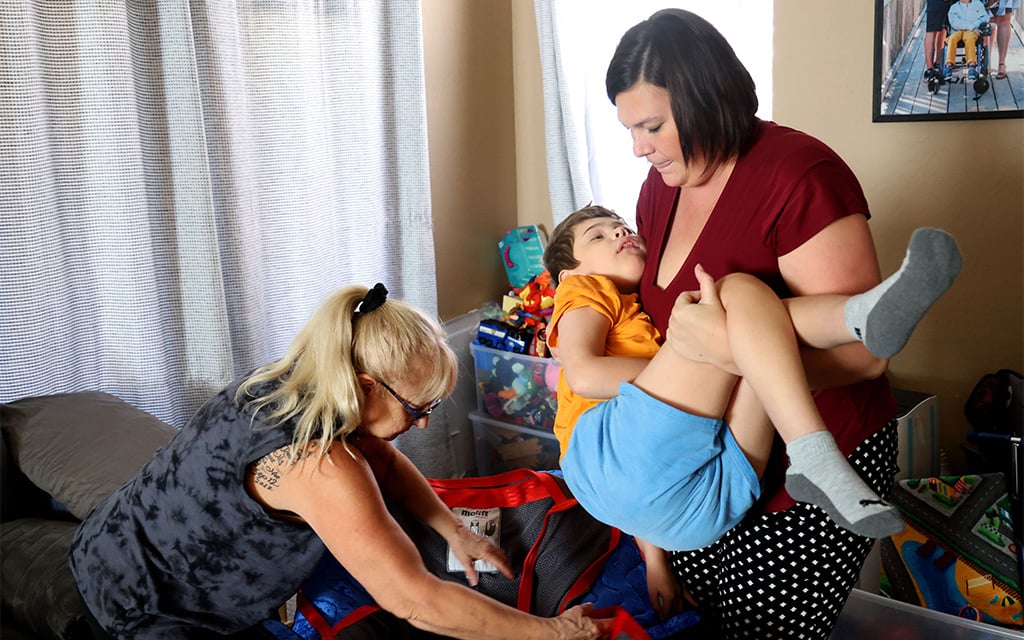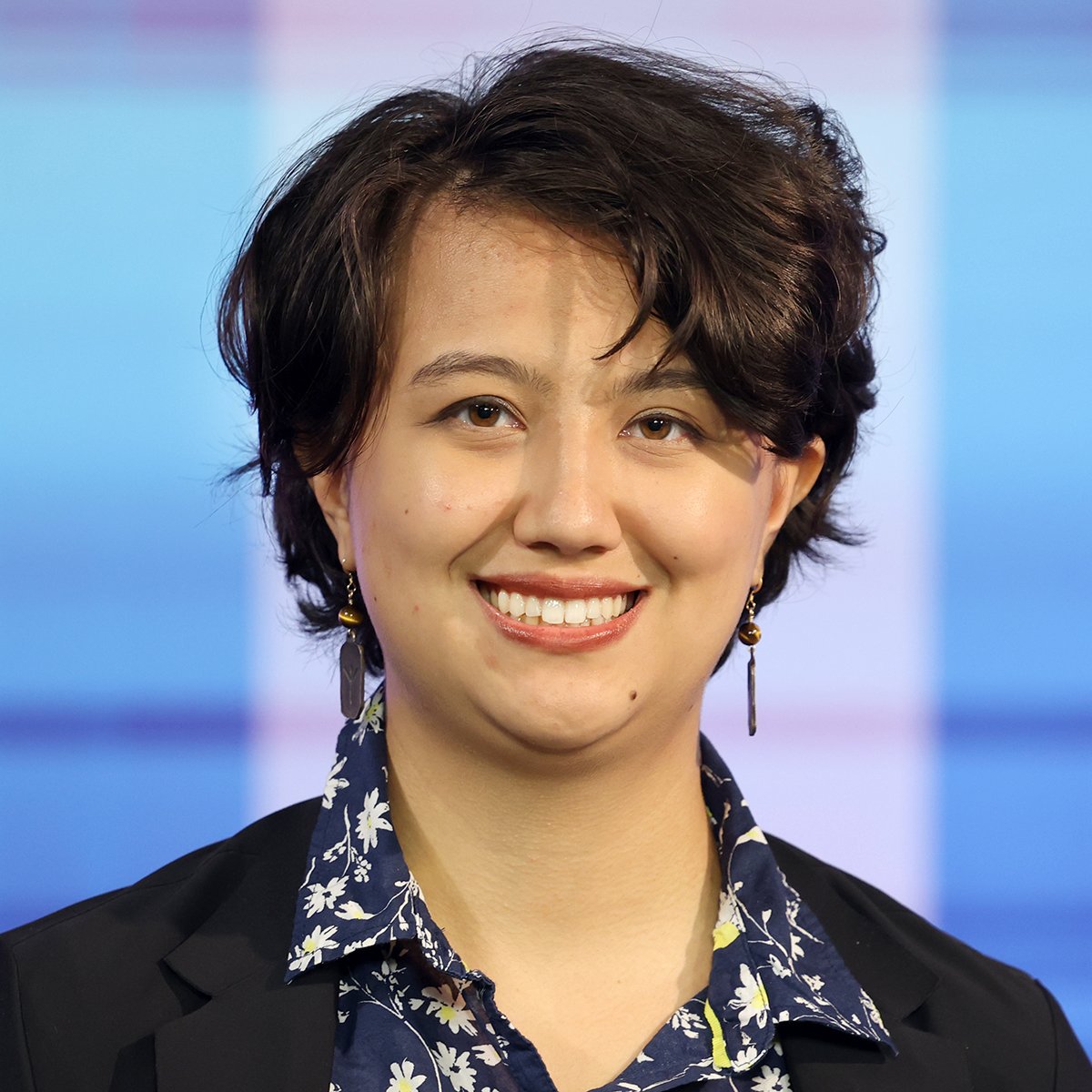
Brandi Coon, right, lifts her son, Tyson, to put him into a sling that Ronda Barnes prepares, on Oct. 6, 2023. Coon works alongside Barnes, her son’s non-familial paid caregiver, to provide the care Tyson needs. (Photo by Kevinjonah Paguio/Cronkite News)

Ronda Barnes, Tyson Coon’s non-familial paid caregiver, covers Tyson with a blanket on Oct. 6, 2023. (Photo by Kevinjonah Paguio/Cronkite News)
QUEEN CREEK – Tyson Coon turns 9 this November. He enjoys reading and watching Disney movies, such as “Frozen” or “Moana.” He’s the oldest of three boys, whose names all begin with the letter T.
When Tyson was 6 months old, he had bacterial meningitis that caused what his mother, Brandi Coon, described as “massive strokes throughout his brain.” As a result, Tyson has a severe type of epilepsy known as Lennox-Gastaut syndrome, cerebral palsy, right-sided blindness and oral dysphagia, a condition that affects his mouth, tongue and lips.
These diagnoses have different impacts on his life. Because of his dysphagia, Tyson uses a gastrostomy tube that delivers food and drink directly to his stomach. He also uses an alternative communication device that enables him to press buttons to select words he wants to say. Because of Lennox-Gastaut syndrome, he has two or more seizures each day.
In 2020, as a result of the COVID-19 pandemic, the Arizona Health Care Cost Containment System requested and was granted emergency flexibility to use funds to pay parents for providing specialized care to their children under 18. Though the flexibility was previously extended, it is currently set to expire in March 2024. A proposal submitted by AHCCCS to the Center for Medicare and Medicaid Services (CMS) this September, however, would permanently extend the program, allowing parent caregivers who meet direct care worker requirements to be paid for up to 40 hours a week.
Brandi Coon is one of those parent caregivers and the co-founder of the Raising Voices Coalition, an Arizona organization that advocates for a permanent paid parent caregiver program. Coon started being paid as a caregiver under the emergency flexibility provision after going through training in 2020.
“Overnight, I turned into about 15 different people,” said Coon about caring for her son during the COVID-19 public health emergency.
“I was not only his (Tyson’s) mom, but I was his therapist. I was his caregiver. I was his nurse. I was his teacher. And I had to immediately assume all those roles with the help of, you know, professionals on Zoom.”
Currently, Coon is still being paid for providing care to her son, though Ronda Barnes, Tyson’s other paid caregiver, continues to come and assist with Tyson’s various therapies, including speech and physical therapy. Barnes has been Tyson’s paid caregiver since last December, and is, Coon estimated, the non-familial caregiver who has spent the second-longest amount of time with Tyson. Tyson himself, Coon said, has had “probably about 10 different aides” over the course of his life at this point.

Brandi Coon talks with her son Tyson, who is non-speaking and uses an alternative communication device to communicate with others. (Photo by Kevinjonah Paguio/Cronkite News)
Barnes is supportive of Coon’s advocacy for paid parent caregivers. She said there isn’t a lot of specialized care of this kind available.
“I think it’s great. I think, you know, if you can’t go to work because … you can’t leave the child alone … I think they should get paid to help…just like I get paid.”
Coon herself has had to make decisions about work in order to be available to care for Tyson.
“I’ve created it (my business) so that it’s extremely flexible, so that if I … were to be in the hospital with him for two weeks, that my business that I run wouldn’t suffer.”
In 2020, according to KFF, an estimated 5.8 million people used paid long-term care services, including assistance with eating, hygiene, medication management and dressing. According to PHI (formerly the Paraprofessional Healthcare Institute), an organization that advocates for and conducts research on direct care workers, including those providing at-home care, 15% of home care workers live in households below the federal poverty line and 16% of home care workers work more than 40 hours per week.
“It’s a workforce with a lot of turnover. It’s a workforce that doesn’t pay particularly well and it’s a workforce that has a lot of demanding requirements and emotional requirements of the worker,” said Alex Demyan, assistant director for the Division of Community Advocacy and Intergovernmental Relations at AHCCCS.
“When there’s a gap between that assessed need and the immediate availability of providers, parents have to kind of pick up the slack there,” Demyan said. “Historically, they have not been reimbursed for that work, so … we kind of view this program as a step in the right direction to help address that workforce need.”
Though Coon says she’s happy with the care she and Barnes provide for Tyson, she has heard of other families having difficulty retaining caregivers.
“One of the … struggles that families have is like, ‘OK, I get a great provider, but then six months later, they’re not there,’” said Coon.
For Coon, knowing her son’s needs as a mother enhances her ability to care for him.
“Oftentimes when an outside care provider comes in, they’ve received general training, but they don’t have specific training on what my child needs,” Coon said.

Tyson Coon operates his alternative communication device on Oct. 6, 2023. “This is my talker. It helps me speak,” Tyson said via his device. (Photo by Kevinjonah Paguio/Cronkite News)
“And so, typically I will provide anywhere from 40 to 60 additional hours of training on my child once that person starts, to get them caught up to speed and to take care of him safely.”
Currently, paid parent caregivers in Arizona can bill an unlimited number of caregiving hours. The AHCCCS proposal, however, plans to phase down the allowed amount of billable hours, starting with a limitation of 80 hours a week from Feb. 1 to May 31, 2024, and going down to 40 hours a week by the end of 2024.
“In an ideal circumstance, the children would have outside providers for that care that’s above and beyond 40 hours a week and hopefully a lot of families do provide that support because that’s really needed,” Coon said.
“But what we’re hoping is that the state will allow for a flexibility or an exception clause to families who really cannot find that outside support above and beyond 40 (hours).”
As the proposal awaits federal action, Tyson’s family and caregiver Barnes continue to care for him and support his needs.


